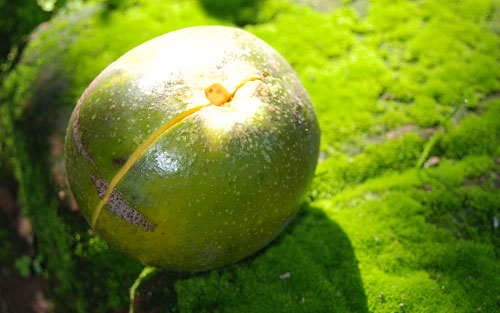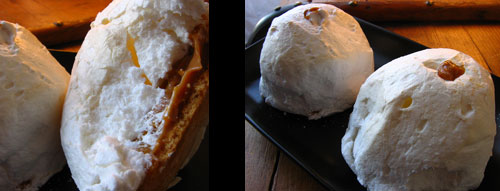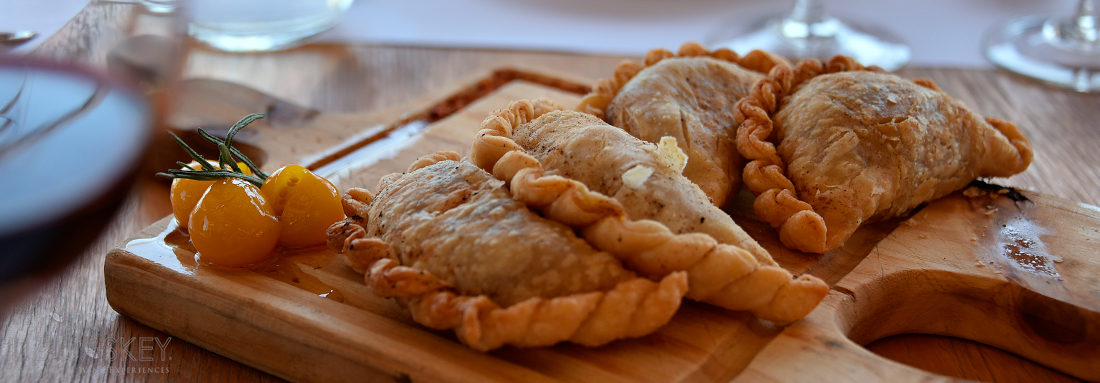
Perhaps Chile’s most undiscovered fruit abroad, if you quiz any Chilean on their favorite dessert combination it most likely will consist of a) manjar b) lucuma and c) meringue. It is a match made in heaven.
Lucuma is an orange-yellow baseball-shaped fruit that is grown in the cooler regions near the coast in Quillota and La Ligua, northwest of Santiago. The short trees, which rather look like bushes, reveal their fresh fruit in the winter months. In its natural (raw) state, lucuma resembles a brown baseball. Crack it open and the orange, pulpy flesh is aromatic with a slightly sweet taste. This is NOT a fruit you would want bite into—no, no, no. To consume it, it is pureed raw in a blender, forming a paste sweetened with a little sugar and milk. The paste reminds me of a “light” peanut butter with its toasty flavor and creaminess. It can also be frozen in chunks for adding to smoothies. Taste-wise, the closest comparison I have found is Butter Pecan. It is nutty and caramel-laden at the same time but not so sugary; its inherent flavor is such.
Chileans crave Lucuma, especially in old school desserts like meringue cakes, or paired in any form with manjar. They especially love lucuma in ice cream. In fact, the Lucuma-manjar combination is so good that it brings many devotees (my husband included) to their knees. As Francisco says, “The U.S. goes crazy for peanut butter-chocolate; we go crazy for manjar-lucuma.”
Lucuma is used so extensively in sweets, cakes, pastries, ice creams, yogurts, and jams that it is now trying its luck abroad. Companies like Guallarauco are exporting the paste ready to be whipped into smoothies, brownies, even on toast. I take it to the US as an exotic gift for adventuresome foodie friends.
Of all the lucuma temptations, perhaps the traditional Dulces Chilenos, Chilean sweets, are my favorite. I luckily stumbled upon them one afternoon several years ago on a romp around my block in Bellas Artes neighborhood. Enticed by the smell of sweet meringue baking, in a non-descript bakery window, I was reeled in by visions of puffy meringue kisses. I felt giddy like a little girl contemplating which of the glistening sweets I would first sink my teeth into. Here I met my friend, María Luisa, who at 75 (going on 20 I may add) has dedicated her life to the art of colonial-style pastries.
With my saliva glands working overtime, I opted for a dulce chileno made with manjar and lucuma, topped with a gallop of meringue and baked. Chomping into it was like biting into a pillowy piece of a sinfully sweet, sugary cloud that dissolves on your tongue. This is followed by the deep milkiness of the caramel, the nutty lucuma, and a crunchy cookie. Mind-blowing. When I asked Francisco what he thought of the sweets, I realized I didn’t need an answer. His eyes had already rolled back into their sockets.
This is my friend Maria Luisa’s most traditional recipe. Fair warning: these do require a little work (and a mixer) but will induce ecstasy promptly. An espresso is also recommended for maximum pleasure. If you are in Santiago and want to forego the fuss, visit Maria Luisa at Robymar on Monjitas, a few shops before José Miguel de la Barra. The only sign says Pasteleria (bakery).

Chilean Sweets with Milk Caramel, Lucuma, and Merengue
Basic Egg Pastry:
1.5 cup (325 grams) plain (all-purpose) flour
Pinch of salt
1 teaspoon baking powder
4 large egg yolks
1-2 tablespoons cold water (only as necessary)
Preheat oven to 375ºF/190ºC.
Sift the flour with the baking powder and salt onto a work surface. Make a well in the center; add the yolks one by one, working together with your fingertips. Gradually pull in the flour and knead until dough is satiny and very elastic. If it is too wet, adding flour; or if too dry, add water tablespoon by the tablespoon. Roll out the dough with a rolling pin to 1/8-inch thickness (3-4 millimeter). Cut the dough into rounds of 2 ½ inches wide (6 centimeters). Prick the dough with a fork (this will help keep them flat while baking) and transfer to a lightly greased and floured baking tray.
Bake for 5-7 minutes or until golden brown. Remove from the oven and let cool thoroughly.
Italian-Style Meringue:
½ cup water
1 cup sugar
4 large egg whites, at room temperature
Pinch of salt
Place the water and sugar in a small saucepan over medium heat. Bring to a boil, stirring occasionally. When the mixture has reached a boil, stop stirring and let the temperature rise to 248ºF (120ºC) on a candy thermometer. This will take about 3-5 minutes once at a boil.
Meanwhile, beat the egg whites with salt to form stiff peaks. With the mixer running, add the hot sugar syrup to the egg whites in a continuous thin stream. Continue to beat until cold. The meringue should look glossy and be very stiff.
Assembly:
9 ounces (250 grams) manjar (substitute: dulce de leche or cajeta)
4.5 ounces (125 grams ) Lucuma paste (If hard-to-find you can substitute crushed walnuts or even natural peanut butter)
Spread a generous tablespoon of the manjar in the center of a pastry round, using a spoon to cover evenly. Repeat with the Lucuma paste. Using a small spatula, place a dollop of the meringue on top. Smooth the sides and top to form a dome-shaped puff. Place a tear drop of manjar on the top of each pastry. Place on a tray and return to the oven for 15 minutes until lightly golden and slightly firm to touch. Let cool for another 15 minutes to let meringue harder slight. Serve at room temperature. Biting into these treats is like biting into a sweet, soft cloud!
Makes 10-12.












